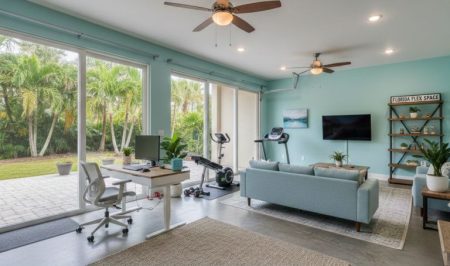In the contemporary landscape of property protection, the crude, visible vestiges of traditional home defense—such as jarring spotlights and bulky cameras—are giving way to non-obtrusive architectural integration . This represents a crucial evolutionary step, moving from a reactive stance to a proactive, integrated design philosophy rooted in Environmental Crime Prevention (ECP). The modern homeowner no longer faces the binary choice between preserving the aesthetic integrity of their residence and ensuring its absolute security; the most robust residential fortification is, by definition, the one least conspicuous.
This article delves into a layered defense philosophy, exploring the critical architectural and technological components—from cunningly designed landscape features to sophisticated smart living technologies—that operate in concert to not only deter potential intrusions but also to substantially enhance the dwelling’s overall value and livability, fulfilling the core need for effective, yet beautifully inconspicuous, safeguarding. By systematically analyzing the foundational concepts of Layered Defense, ECP, and Intelligent Automation, we demonstrate how the deliberate, subtle placement of various design elements constitutes an overwhelmingly effective, virtually undetectable security perimeter.
The strategic deployment of New Bern permanent outdoor lights, such as those provided by services common in areas like New Bern, represents a prime example of seamlessly blending security functionality with aesthetic design. These high-end, professionally installed LED systems are mounted beneath the eaves or fascia within a low-profile, color-matched track, making them virtually invisible during daylight hours. Their true defense value lies in their ability to transition instantly from decorative holiday patterns to full-spectrum, static white security illumination, which can be remotely triggered or automated to turn on to maximum brightness in vulnerable zones when a smart camera detects anomalous motion. This feature provides a powerful, dynamic response to perceived threats, ensuring the property is constantly protected without requiring the visual disruption of permanently visible floodlights.
What are the key subtle design features for advanced, secure access management?
The key subtle design features for advanced, secure access management revolve around embedding sophisticated defense technology into the home’s architecture with such precision that the protective mechanism becomes practically indistinguishable from standard fixtures. This progression requires moving past the bulkiness of traditional deadbolts and visible keypads to deploy entities such as Intelligent Locking Systems, Biometric Verification Methods, and Hidden Communication Portals, all of which fulfill the requirement of being exceptionally functional yet aesthetically minimal. The guiding design philosophy mandates that the security barrier must be instantaneously accessible and intuitive for authorized residents, yet appear practically invisible and robustly impenetrable to any unauthorized individuals. These subtle integrations drastically enhance everyday residential convenience while simultaneously elevating the physical and digital threshold for unauthorized entry significantly beyond what standard mechanical key systems can offer.
Architecturally Concealed Intelligent Locking Systems
Architecturally concealed intelligent locking systems are engineered to either completely replace or meticulously integrate with existing door hardware, thereby preserving the original aesthetic integrity of the entryway while incorporating powerful electronic safeguarding features. These advanced systems frequently forgo exterior keypads in favor of discreet fingerprint sensors or utilize the resident’s mobile device as the primary digital credential via secure Bluetooth or Wi-Fi communication protocols. A significant number of contemporary intelligent locks are designed to be fully housed within the body or frame of the door itself, leaving no external visible evidence of their technological complexity, allowing the home’s high-end, visual hardware to remain pristine. Their core value lies not just in granting seamless, keyless ingress, but also in automatically generating an immediate, auditable digital log of every access attempt, thereby adding a vital layer of data-driven surveillance to the fundamental physical barrier.
Integrated Biometric Verification
Integrated biometric verification involves discreetly embedding highly accurate fingerprint, facial, or retina scanning hardware into existing architectural components near the point of entry, such as within the door handle itself, a specialized wall panel, or even integrated into the surrounding door frame. Unlike prominent, standalone biometric reading devices, these integrated systems are flush-mounted or completely concealed, only confirming their technological presence when an authorized user initiates interaction with the specific, designated area. This approach achieves the highest echelon of personal security—given that biometric data is virtually impossible to fraudulently replicate—while maintaining a clean, contemporary aesthetic. The subtle integration ensures that this advanced technology is only a point of focus for the genuine resident, not for a casual observer or a potential criminal.
Subsurface Intercom and Communication Portals
Modern access management systems frequently incorporate high-definition video communication portals and intercoms for secure visitor identification, but their design is intentionally minimized to avert an intrusive or institutional appearance. Subsurface communication portals are often expertly built into load-bearing wall surfaces, integrated into the door trim, or even ingeniously concealed within the house number plaque or a piece of ornamental exterior lighting, minimizing their visibility to only a tiny, pinhole lens and a microphone grille. The corresponding video monitoring screens inside the home are typically designed as elegant, minimalist wall-mounted touch panels that often double as the primary central control hub for the entire automated home system. This calculated concealment guarantees that the resident benefits from constant, high-fidelity monitoring without the visual imposition of a large, obvious security console.
Reinforced Entryways with Architectural Finishing
The door and its surrounding frame constitute the final and most critical physical point of defense, and contemporary designs achieve extreme structural fortification while maintaining an outwardly unremarkable appearance. High-security residential doors are frequently constructed with internal reinforced steel matrices and advanced multi-point locking mechanisms, yet they are faced with sophisticated, luxurious wood veneers or contemporary metal laminates that perfectly match the dwelling’s overall design scheme. The frame is purposefully engineered to hide the industrial bolt receivers and anti-jimmy reinforcement plates, making the entire assembly appear merely as a standard, premium-quality entrance system. This methodology represents the ultimate realization of discreet design, where the inherent structural security is entirely invisible, concealed beneath a perfectly integrated and aesthetically refined surface.
How is surveillance accomplished with discreet, architecturally integrated visual monitoring systems?
Surveillance is accomplished through the strategic deployment of discreet, architecturally integrated visual monitoring systems that shift the emphasis from obvious, intimidating display to continuous, high-fidelity capture, a process intrinsically linked to Topical Authority on Invisible Vigilance. The goal is not merely to record, but to capture comprehensive, evidence-grade footage without alerting the subject to the surveillance, thereby avoiding the common criminal tactic of disabling or circumventing visible cameras. This is achieved by transforming ordinary architectural elements—such as gutters, vent soffits, or exterior lighting fixtures—into concealed housings for miniature, wide-angle, and high-resolution cameras. This subtle integration ensures that constant, comprehensive visual coverage is maintained across all vulnerable sectors of the property without compromising the exterior’s design integrity, effectively normalizing the presence of continuous monitoring.
Subtle Exterior Camera Housings
Subtle exterior camera housings are meticulously designed to mimic or become intrinsic parts of existing outdoor structures, making them functionally invisible. For example, high-definition bullet cameras are often built into custom-designed housings that blend seamlessly with the home’s gutter systems, or dome cameras are integrated so flushly into the underside of the eave soffits that they appear to be standard ventilation ports. The finishes, colors, and textures of these housings are specifically chosen to match the surrounding architectural materials, ensuring that the devices blend into the background rather than stand out as technological anomalies. This level of camouflage ensures that surveillance remains a constant, silent observer.
Integrated Video Verification with Intercoms
Integrated video verification involves combining the function of a high-quality camera directly within the unit of a smart doorbell or an entryway intercom system. Unlike earlier models that were visibly large, modern systems utilize narrow, vertically oriented lens arrays that are minimally noticeable. Crucially, these systems initiate high-speed, local recording immediately upon detecting motion or a button press, providing crucial video evidence of any person approaching the property. The seamless connection of the video feed to the indoor control panel or a resident’s remote device facilitates instant, secure visual identification of visitors without requiring the resident to physically approach the door, thereby enhancing security through remote control.
Landscaping and Architectural Feature Camouflage
Advanced visual defense utilizes landscaping and other architectural features to conceal monitoring devices. Cameras are often hidden within specially designed garden ornaments, birdhouses, or hollowed-out landscape lighting units, providing unique, low-angle vantage points that cover critical ground areas such as driveways and walkways. For areas requiring less permanent monitoring, miniature cameras with wireless transmission capabilities can be temporarily or semi-permanently concealed within decorative planters or custom-built faux rock structures. This technique leverages the property’s existing aesthetic complexity to provide comprehensive, multi-perspective coverage that is highly resistant to both detection and tampering.
Smart Video Analytics and Alerting
The true intelligence of a discreet surveillance system lies in its smart video analytics, which eliminate the need for constant human monitoring by autonomously detecting and differentiating genuine threats. Modern systems are programmed to utilize features like object recognition (identifying packages, vehicles, or pets), loitering detection (flagging individuals who linger too long in a specific zone), and tripwire alerts (notifying when a person crosses a designated virtual boundary). This capacity for intelligent filtering drastically reduces the number of false alerts, ensuring that when an notification is issued, it signifies a high-probability security event, allowing the homeowner to respond decisively and immediately to actual threats.
How is advanced system interoperability achieved for unified property safeguarding?
Advanced system interoperability, also known as Smart Home Integration, is achieved by using a unified communications protocol that allows disparate security components to communicate and function as a single, cohesive entity, a critical element in establishing Topical Authority on Intelligent Residential Systems. This integration ensures that the security infrastructure—including access control, lighting, and surveillance—is no longer a set of isolated functions but a dynamic, responsive ecosystem. For example, a single trigger event, such as an external camera detecting a person lingering by the fence, can automatically initiate a coordinated response: the perimeter lights intensify, the smart locks verify their armed status, and a dedicated video stream is sent to the homeowner’s mobile device. This level of centralized, intelligent command optimizes response time, reduces instances of system failure, and provides a continuous, real-time awareness and remote management capability far exceeding the passive nature of traditional security setups.
Standardized Communication Protocols
The foundation of interoperability relies on standardized, secure communication protocols, such as Z-Wave, Zigbee, or a high-security Wi-Fi mesh network, that act as the common language for all defense components. These protocols ensure that a smart lock from one manufacturer can reliably trigger a light bulb or a camera from another, guaranteeing system flexibility and scalability. The network architecture is often concealed, utilizing low-power, wide-range signals that do not require visible hubs or extensive, ugly wiring, maintaining the home’s minimalist aesthetic while supporting a high volume of secure, real-time data exchange among all connected devices.
Centralized Command and Control Hub
A centralized command and control hub serves as the brain of the integrated defense system, collecting data from all sensors, processing the information against pre-set security logic, and issuing corresponding commands. This hub is often disguised as a sleek, wall-mounted digital tablet or built into an existing appliance, reducing its visual prominence while maximizing its utility. This single point of command allows the homeowner to manage all aspects of the property’s security—from arming and disarming to reviewing historical events and managing visitor access—through one intuitive, secure interface, making high-level security management surprisingly simple.
Dynamic Scene and Rule Creation
Interoperability allows for the creation of dynamic scenes and rules that automate complex security responses based on multi-variable inputs. A “Vacation Scene,” for example, could automatically secure all doors, activate the random occupancy simulation lighting, reduce the HVAC setpoint, and switch the camera system to maximum-sensitivity recording. Conversely, a “Disarm Scene” triggered by a biometric lock could simultaneously turn on kitchen lights and unlock the garage door. This ability to define intricate, conditional logic ensures the security system is constantly adapting to the homeowner’s status and environmental changes.
Remote System Diagnostics and Updates
A crucial, often-unseen benefit of a highly integrated system is the capability for remote system diagnostics and over-the-air (OTA) software updates. This allows the system provider or the homeowner to troubleshoot issues, calibrate sensor sensitivity, and apply security patches without physical intervention. Continuous, remote updating ensures that the defense system remains protected against the latest digital vulnerabilities and that its performance is constantly optimized, guaranteeing sustained, reliable operation and long-term security efficacy.
What is the foundational concept behind a multi-layered property defense system?
The foundational concept driving a multi-layered property defense system is Environmental Crime Prevention (ECP), a principle that posits that the built environment can be engineered to systematically discourage criminal activity. This intellectual framework transcends the simplistic deployment of singular devices like alarms or surveillance systems, instead prioritizing how the manipulation of architectural and landscape features can preemptively influence behavior and minimize opportunities for wrongdoing. A layered defense, by its definition, mandates that multiple, distinct security measures are deployed, each acting as an independent barrier, such that the compromise of any single element fails to critically undermine the entire system’s integrity. ECP is recognized as the essential, overarching concept that holistically unites elements such as Physical Fortification, Surveillance Implementation, and Access Management into a single, cohesive, proactive strategy. Successful application of ECP ensures that safety becomes an intrinsic, pre-planned component of the home’s original design, fundamentally altering the calculus of risk for any potential aggressor.
Supervised Visibility
Supervised visibility, a core tenet of ECP, dictates that a space must be designed to allow inhabitants and their neighbors clear, unimpeded sightlines across the property and into adjacent public areas, effectively turning the immediate environment into its own active security presence. This is accomplished through meticulous planning of sightlines, such as maintaining low-level, sparse shrubbery near all ground-floor openings and strategically positioning structural windows to maximize observation from within the home. A prospective intruder is dramatically less likely to attempt a breach when the perceived probability of immediate observation is high, illustrating the direct causal link between design intervention and security outcomes. Effective supervised visibility acts as a powerful psychological barrier, organically transforming a neighborhood into a network of mutual, protective vigilance purely through intelligent, open-space planning.
Proprietary Definition
Proprietary definition involves utilizing architectural elements to clearly delineate private domain from public access, discouraging unauthorized intrusion and establishing a strong, unambiguous sense of ownership. This is achieved using both actual and symbolic barriers, which can include low, ornamental walls, distinct variations in paving materials, or intentional landscaping choices that visually and physically mark the boundary between communal and private space. The primary objective is to project an unequivocal visual message that the area is actively maintained and accountable to its occupants, thereby raising the psychological threshold for unauthorized trespassing. Simple yet effective design elements, such as the strategic placement of external lighting or the aesthetic treatment of an entrance gate, powerfully contribute to this proprietary distinction, reinforcing the perceived security of the perimeter.
Regulated Movement
Regulated movement utilizes intentional physical design to steer legitimate pedestrian and vehicular traffic along predictable paths while simultaneously discouraging unauthorized or covert movement toward vulnerable areas of the property. This involves planning the precise location of entrances, exits, and pathways to channel all visitors through well-lit, easily observed zones. Features like challenging, dense, or prickly plant species deliberately placed beneath ground-floor windows, or winding paths that require visitors to remain in sight for longer durations, serve to manage and restrict movement. The architectural plan deliberately minimizes the number of potential approaches an intruder can utilize, making the property easier to monitor and reducing blind spots, consequently strengthening the overall defense profile without resorting to overtly aggressive physical barriers.
Environmental Stewardship
Environmental stewardship is a critical, often-overlooked dimension of ECP, as a meticulously maintained and well-cared-for property projects an image of diligence and active ownership—a potent psychological deterrent. Conversely, a neglected residence—characterized by overgrown hedges, non-functional exterior illumination, or visible decay—suggests low vigilance and high opportunity for opportunistic crime. Consistent and prompt upkeep of all structural elements, exterior illumination systems, and landscape features not only ensures their continued functional integrity but also broadcasts an unmistakable message of active monitoring and ongoing management. This sustained commitment to the property’s pristine condition is a subtle, yet immensely effective, element of the comprehensive defense strategy.
How are boundary markers and walls blended into the terrain as discreet protection components?
Boundary markers and walls today serve a far more complex function than simply denoting property lines; they function as sophisticated, multi-layered defense strata seamlessly incorporated into the exterior design. The guiding principle is to select materials and designs that perfectly align with the home’s architectural idiom while simultaneously constituting a significant physical and psychological impediment, a concept that links directly to Blended Perimeter Defense. Rather than employing visually heavy, dominating structures, the modern methodology champions designs that leverage variations in height, natural material textures, and precise placement to achieve maximum safety with minimal visual imposition. This integrated approach transforms the boundary from a mere partition into the initial, often unseen, line of defense, making any attempt to scale or breach the boundary appear to require disproportionate effort relative to the potential gain. The thoughtful design ensures that the barrier actively contributes to the property’s curb appeal while sustaining an uncompromised level of physical security.
Perimeter Material Optimization
The selection of the appropriate perimeter material is paramount for harmonizing high security with aesthetic appeal. Moving away from opaque, heavy concrete structures, contemporary designs often favor materials such as ornamental metalwork fencing with narrowly spaced vertical rods that offer minimal handholds, or aesthetically pleasing stone gabion walls that fuse natural rock with a concealed rigid structure. The material choice must conceptually convey resilience without hostility. Utilizing muted colors or materials with natural textures allows the perimeter structure to visually recede into the surrounding landscape. The inherent resilience and construction integrity must be robust enough to effectively resist attempts at forceful entry, yet its final appearance must remain subtle, artfully masking its primary function as a security component.
Strategic Elevation and Transparency
The deliberate control of fence and wall height, coupled with varying levels of transparency, is vital for maintaining a non-obtrusive appearance while maximizing the defense utility. A lower wall or fence at the street-facing front, potentially augmented by dense, anti-climb plantings, can satisfy the ECP mandate of Supervised Visibility, whereas a taller, more solid structure may be strategically placed at the rear for enhanced privacy and heightened security. Designs frequently incorporate stepped elevations or visually engaging elements like decorative screening or strategically placed voids that prevent the barrier from appearing overly fortress-like. By calibrating the height and visual density according to the specific vulnerabilities of different sections of the property, the perimeter defense system is optimized without generating a uniform, imposing presence.
Landscape as a Physical Barrier
The practice of integrating specific types of plant life directly with the perimeter structures transforms soft-scape elements into hardened security features. This involves the deliberate planting of thorny, closely knit, or rigid plant species, such as specific cultivars of juniper, hawthorn, or prickly pear, immediately beneath vulnerable window areas or along the base of the boundary. These plants serve as a secondary, physically prohibitive layer, significantly discouraging any attempt at unauthorized access without the need for visible, aggressive security hardware. The resultant benefit is dual: the landscaping enhances the natural beauty of the property while its functional characteristics quietly and effectively contribute to the overall perimeter defense strategy.
Embedded Detection Systems
Discreet security is significantly augmented by integrating sophisticated detection elements directly within the physical structure of the boundary. This includes embedding low-voltage, highly directional illumination sources within the wall cap or fence line to eliminate all dark recesses, which are prime cover spots for potential intruders. Furthermore, advanced pressure- or vibration-sensitive fiber optic cables or highly localized seismic sensors can be concealed within the core of a wall or the subsurface beneath a fence to immediately trigger an alert upon attempts at climbing, breaching, or digging, often before the actual intrusion is successfully executed. These elements remain completely imperceptible to the casual eye, representing the apotheosis of blended design, where the physical boundary functions as an intelligent, constant monitoring device.
What functions does integrated exterior illumination perform in sophisticated, low-profile crime prevention?
Integrated exterior illumination serves a critical function as one of the most effective, yet entirely non-obtrusive, methodologies for crime prevention, conceptually linking the concept of Architectural Lighting with Active Defense Protocols. Strategically designed illumination eliminates the deep shadows and dark zones that intruders rely upon for concealment, thereby drastically escalating the perceived risk of exposure. In stark contrast to glaring, disruptive floodlights, integrated systems utilize precisely positioned, low-intensity fixtures that are engineered to merge seamlessly with the landscape architecture, providing illumination that is visually comfortable for residents but profoundly detrimental to clandestine activity. The system’s effectiveness lies in its capacity to manipulate the intruder’s risk calculation: if they cannot secure reliable cover, the likelihood of an attempted intrusion plummets. This refined approach guarantees that the property remains warm and aesthetically inviting while simultaneously projecting an unyielding, constant, and discreet defense presence.
Footpath and Accent Lighting
Footpath and accent lighting serves the dual purpose of safely guiding residents and visitors while critically supporting the defense apparatus by neutralizing potential hiding spots along walkways. By illuminating all paths, steps, and key architectural accents, the system ensures that any movement across the property is clearly visible, acting as a direct deterrent to trespassers who inherently prefer to operate under cover of darkness. This illumination is typically achieved using low-voltage, concealed or soft-glow fixtures that cast controlled, focused light. The emphasis is on precise light distribution, meaning the light is directed only where required, enhancing the design without contributing to light pollution, thereby maintaining the property’s refined nighttime aesthetic while maximizing surveillance capability.
Strategic Light Sculpting (Uplight/Downlight)
The strategic use of uplighting (directing light upwards onto walls, trees, or structural columns) and downlighting (directing light downwards from elevated points, such as eaves) are essential techniques for highlighting a home’s features while simultaneously generating visual “hot spots” that eliminate deep, criminogenic shadows. For instance, uplighting a large tree not only creates a striking visual spectacle but also prevents the area beneath the canopy from becoming a hidden alcove. Downlighting, frequently installed beneath rooflines or in pergolas, provides uniform, comprehensive illumination over all crucial entry points. This deliberate, dual-purpose lighting design actively sculpts the nocturnal environment, ensuring that every significant area of the property is clearly exposed and observable, a cornerstone of sophisticated ECP application.
Dynamic Motion Activation
The implementation of motion-activated lighting, seamlessly layered alongside the always-on ambient illumination, provides a dynamic and highly effective deterrent without the energy consumption or visual distraction of continuous bright light. The baseline illumination maintains the aesthetic and foundational security, while the concealed, motion-activated fixtures trigger an immediate, high-intensity burst of light only upon sensing movement within specific, vulnerable zones. This sudden change in luminosity not only startles any potential intruder but also instantly draws the attention of occupants and neighbors. The key to its discretion is its concealment: the sensors and fixtures are designed to be virtually invisible during daylight hours, only mobilizing as an active defense element when the environmental conditions demand it.
Intelligent System Automation
Modern, discreet defense illumination relies heavily on Intelligent System Automation, which enables complex, randomized scheduling and remote command functionality that accurately simulates genuine occupancy. Via specialized control hubs or mobile applications, homeowners can program lighting sequences that vary in timing, color temperature, and intensity, convincingly giving the appearance of an occupied residence even when vacant. This capability extends beyond simple on/off timers; advanced systems can synchronize color shifts, simulate the subtle activity within rooms, and even coordinate their actions with other automated home devices. This highly intelligent, dynamic control ensures the lighting defense is never static or predictable, furnishing an evolving and effective security deterrent that is exceptionally challenging for criminals to study or neutralize.
Conclusion
The contemporary approach to residential fortification unequivocally demonstrates that the most advanced protection is achieved through thoughtful, non-obtrusive architectural integration. By meticulously weaving together the principles of Environmental Crime Prevention, Blended Perimeter Defense, Intelligent Access Management, and Covert Visual Monitoring, homeowners create a sophisticated, layered defense that is robust in function and negligible in visual impact. The coordinated deployment of features—from strategically placed, low-intensity illumination that sculpts away shadows, to smart locks concealed within high-design door hardware—transforms the property’s aesthetics into its primary security asset. This commitment to seamless fusion ensures that the defensive infrastructure does not detract from the home’s ambiance or value. Ultimately, a truly safe and fortified residence is one where the security apparatus is so deeply integrated into the dwelling’s design that its powerful, protective presence is inherently felt and respected, rather than aggressively seen.
FAQs (Frequently Asked Questions)
Q: Does installing non-obtrusive security systems comply with standard home insurance policies?
A: Generally, yes, sophisticated, non-obtrusive security systems often lead to favorable insurance outcomes. Insurance providers recognize certified systems, such as those with central monitoring, professionally installed intelligent locks, and integrated surveillance, as high-value deterrents. In many cases, the presence of verified systems that are less prone to physical tampering and offer instant remote verification can qualify the homeowner for substantial premium reductions. It is always advisable, however, to provide your insurer with a detailed list of the system’s advanced features, especially its monitoring and response capabilities.
Q: How do I ensure that my integrated defense lighting doesn’t create excessive light pollution for neighbors?
A: Responsible, integrated defense lighting is specifically designed to minimize light spill and prevent light pollution through precise fixture selection and aiming. Modern systems utilize high-quality, directional low-voltage fixtures, often with shielded or louvered heads, which focus the light exclusively on the intended pathways or walls. The use of motion-activated layers means that bright, high-intensity light is only deployed momentarily and only in response to a potential threat, ensuring that the ambiance remains pleasant and neighborhood-friendly while security functionality is maintained.
Q: Are the sensors used in layered perimeter defense easily tampered with or disabled by intruders?
A: The subtle, integrated nature of modern perimeter sensors makes them inherently difficult to detect, let alone tamper with. Unlike older, obvious external devices, contemporary sensors are often concealed within the wall structure, fence framework, or subterranean wiring conduits. Furthermore, systems utilizing standardized protocols frequently incorporate tamper detection logic, meaning that if a connection is severed or a component is forcefully removed, an alert is instantly generated, turning the attempt at disabling the system into a successful alarm trigger.
Q: What is the maintenance requirement for intelligent access control systems like smart locks?
A: Maintenance for intelligent access control systems is typically minimal and less frequent than for traditional mechanical locks. It primarily involves ensuring a reliable power source (usually battery backup, with alerts sent when power is low) and regular over-the-air software updates, which are often performed automatically via the home’s centralized hub. The electronic components are designed for long-term outdoor exposure. Periodically, cleaning the surface of any exposed biometric scanner to ensure reading accuracy is also recommended.
Q: Can a non-obtrusive surveillance camera capture clear images in complete darkness?
A: Yes, advanced, non-obtrusive surveillance cameras are highly effective in complete darkness, often exceeding the capabilities of larger, older models. They achieve this through two primary methods: first, by incorporating near-invisible infrared (IR) LED arrays that illuminate the scene with light spectrums undetectable to the human eye; and second, by utilizing thermal imaging technology, which captures heat signatures regardless of ambient light. This ensures that clear, usable video evidence is continuously captured, fulfilling the need for 24/7, all-weather invisible vigilance.






